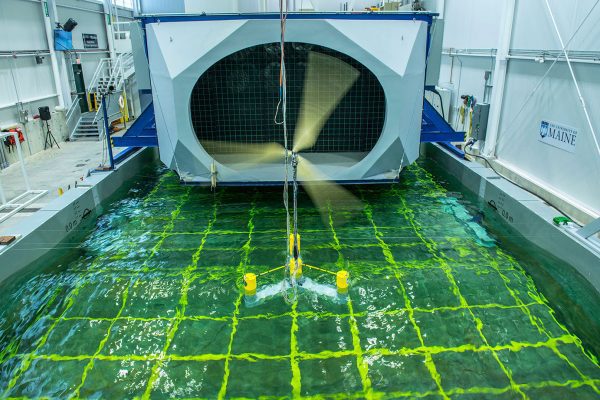The United States has made great strides over the past several years in developing and deploying the clean energy we need to help address the climate crisis. But one area that still holds a great deal of unfulfilled promise for our country – and especially for Maine – is offshore wind, particularly deep offshore wind that might be located 25 or 50 miles from shore.
The Gulf of Maine has some of the strongest and most consistent winds in the world. If we can successfully advance offshore wind to tap this world-class resource, guided by the best scientific research, we will be able to generate large volumes of clean, reliable electricity; create good-paying jobs for Maine people; and take an essential step toward tackling climate change.
Until recently, other countries have led the development of offshore wind, mostly with near-shore projects anchored to the sea floor in shallow waters. Offshore wind in the United States is just getting started, which means that Mainers might have questions about how it’ll work and why it’s so important for our future.
To meet Maine’s climate and clean energy goals, we need significant new sources of renewable energy to replace dirty fossil fuels that are the source of price volatility, and to provide carbon-free power as we transition to electric cars and trucks and electric heating systems. According to the National Renewable Energy Laboratory, offshore wind has the potential to be a major clean energy source for the electric grid that powers Maine and New England – and the winds in the Gulf of Maine peak in the winter months when Maine’s energy use is the highest.
The Gulf of Maine is a shared public resource, and everyone who uses it, especially fishermen and lobstermen, should have a voice in how this resource contributes to Maine’s future needs. Many people are interested in knowing whether wind projects might impact ocean wildlife. We believe that, if developed responsibly, in line with the best data and scientific research available, offshore wind, wildlife, and other activities in the Gulf of Maine can coexist as the state implements critical clean energy strategies to respond to the climate crisis.
The Biden Administration has set a goal to deploy 30GW of offshore wind in federal waters by 2030, including in the Gulf of Maine. In 2021, the federal Bureau of Ocean Energy Management announced a timeline to designate areas for wind energy far offshore in the Gulf of Maine by mid-2023 and enter lease sales for those areas by mid-2024. View the proposed schedule.
The Gulf of Maine covers a vast area of about 36,000 square miles, and most of it is in federal waters. Because Maine ocean waters become deep very quickly offshore, making it difficult to pursue projects anchored to the sea floor, any offshore wind turbines off Maine will be installed on floating platforms far offshore. This technical reality is reinforced by legislative action in 2021 with passage of a ban on offshore wind development within state waters – anything within three miles of Maine’s coastline.
Here in Maine, the Mills Administration is actively pursuing the enormous economic and clean energy opportunities that offshore wind could provide to our state. The Governor’s Energy Office has launched a Maine Offshore Wind Initiative dedicated to the growth of this new industry through strategic planning, research, and coordination with groups from Maine, the nation, and world.

Researchers and scientists at the University of Maine Advanced Structures and Composites Center are developing innovative technology for floating offshore wind platforms. Photo courtesy University of Maine
With leadership from the Governor’s Energy Office, the participants in the Maine Offshore Wind initiative are developing an offshore wind roadmap that would help ensure that any offshore wind development in the Gulf of Maine results in jobs and economic benefits for Maine people by preparing Maine’s commercial seaports, investing in workforce development, and helping advance the University of Maine’s patented floating offshore wind technology.
The first steps in this process are a temporary single-turbine test project off Monhegan Island and a small-scale 12-turbine floating research array being proposed 30 miles offshore. Both projects are being developed in partnership with University of Maine researchers. These projects will allow researchers to better understand the performance of these unique floating platforms, how floating offshore wind in the Gulf of Maine interacts with the ocean environment, and to ensure development is safe and sustainable. This important research will allow the state of Maine, scientists, and advocates to be better-informed participants in the federal leasing process and ensure that we can embrace the huge climate and economic benefits of offshore wind power with no regrets.
The Natural Resources Council of Maine supports efforts by the federal government and Maine to accelerate our investment in offshore wind because it will provide good jobs; help meet our climate goals; deliver clean, reliable electricity to power our homes, businesses, and transportation sector; and protect the future of our environment. Our Climate & Clean Energy Team is collaborating with other conservation groups and participating in the Maine Offshore Wind Initiative to make sure that offshore wind is developed responsibly to protect the Gulf of Maine and provide the greatest maximum benefits to our people, communities, and economy. We’ll continue to keep you updated as these exciting initiatives progress.
— Jack Shapiro, NRCM Climate & Clean Energy Director











Thank you for this informative update Mr Shapiro. Question….will the new infrastructure
bill allow for more funding to directly impact the research being done at UMO?
Looking forward to future updates!
Good question Roger! I haven’t seen anything directly related to offshore wind technology research in the infrastructure bill. Most of the most significant climate and energy policies, including extended support and incentives for wind development (including offshore wind) are included in the Build Back Better Act currently being debated. We are certainly hopeful that all of Maine’s Congressional delegation supports that bill, and are working to make sure that happens.